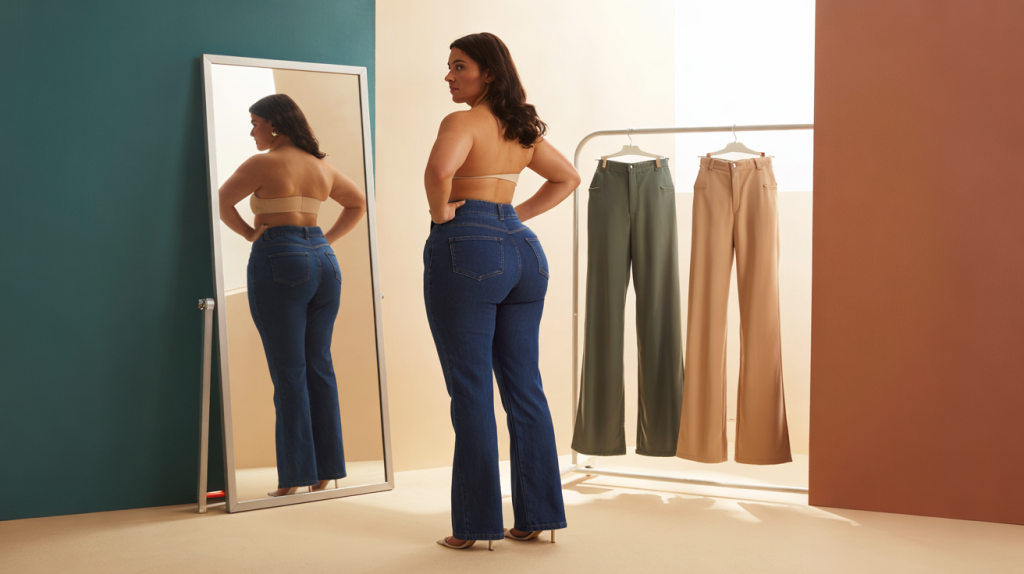Pants for wide hips, solved: what works right now
Wide hips, trim waist, and that infamous gap at the back. The mirror shows pulling at the thighs, pockets flaring, fabric fighting the body. Here is the fast route to pants that sit flat at the waist, skim the hips, and fall clean through the leg.
Curvy blocks with a contoured waistband, a mid to high rise, and a straight, wide or gentle bootcut leg answer the brief. Add stretch with real recovery, and seams that shape rather than squeeze. Shoppers clicked for a fix, not theory. Let’s make it practical, immediately.
Why most pants miss the mark on curvy bodies
Most mass-market trousers start from a straighter fit block. That pattern works on a narrow hip-to-waist ratio, then gets graded up and down. Hips grow, the waist not enough. The result has been seen thousands of times in fitting rooms.
The numbers back it up. According to Narvar’s “State of Returns” report 2018, 41% of shoppers returned apparel for size or fit reasons (Narvar, 2018). That lost time and money often hides one story : a pant that gaps at the waist and strains at the seat.
Body data shows why a one-shape approach fails. The CDC’s NHANES 2015–2018 survey reported a mean waist circumference of 98.3 cm for U.S. adult women, a figure that has increased since 1999 (CDC NCHS Data Brief 360, 2020). Real bodies vary widely in hip projection and waist-to-hip ratio. Size labels rarely tell that story.
How to shop: fabrics, rises and cuts that love curves
Start with rise. A mid or high rise anchors above the fullest point of the hip. It reduces the slide-and-gap effect during the day and smooths the lower belly.
Then the waistband. A contoured waistband that dips slightly at the front and curves higher at the back hugs the small of the back. No more daylight at the yoke. If the tag says “curvy fit”, it usually means extra ease at the hip with a smaller waist measurement.
Fabric matters just as much. Look for a blend with 1 to 3% elastane or elastomultiester and strong recovery. Denim in the 11 to 13 oz range holds shape without digging. For tailoring, choose a drapey wool blend or Tencel-rich twill that glides over the hip.
Leg shape changes everything. A straight leg from the hip down streamlines. A wide leg balances hip width and lengthens the line. A soft bootcut does the same under longer tops, especially with a slight heel.
Construction details help the fit do the work. Back darts and a shaped back yoke, angled front pockets that lie flat, and side seams that sit straight under the armpit show a pant cut for curves. If the side seam is pulling toward the front at mid-thigh, the hip needs more room, not a bigger waist.
Real-world test time. Sit, stand, walk a few steps. If the waistband stays level and the pocket bags do not peek, the block is right. If there is a half-hand gap at the back, try a curvy version of the same model or size down at the waist and choose the hip-friendly cut.
One more thing. Hem length changes proportion. Cropped at the ankle can be chic, but a full-length hem that just kisses the shoe visually narrows the hip line. Tiny detail, big payoff.
ISO has even standardized how brands should measure bodies. “ISO 8559-2:2017” defines key body dimensions for clothing design (ISO, 2017). When a brand follows those definitions, curvy fits tend to be more consistent across sizes.
- Choose a mid or high rise to anchor above the hip curve and stop waist gap
- Pick a contoured waistband and a labeled “curvy” block for extra hip ease
- Opt for straight, wide or soft bootcut legs to balance proportions
- Favor stretch fabrics with strong recovery and drapey wovens for tailoring
- Check side seams and pocket lay to spot pulling before leaving the store
Data, brands and the last 10% that locks the fit
Online size charts rarely map the hip-to-waist difference that curvy bodies need. A chart might list waist and hip, but the hidden factor is the block shape used for grading between sizes. That is why two pants with identical numbers can sit completely differently.
So measure the body, not just the label. Record natural waist, high hip, full hip and the vertical rise from front waist to back waist through the legs. These four points predict whether a block will ride down, pinch or sit right. It sounds fussy, it saves returns.
Brands improve when they cut a separate curvy block rather than tweaking the straight one. Retail sites often note this in fit descriptions with phrases like “curvy through hip and thigh” or “gap-proof waistband”. When that language appears plus the construction cues above, conversion jumps and returns fall. Narvar’s 2018 finding on fit-driven returns tells the business why, and the closet tells the rest.
Tailoring closes the loop. A small waist nip or a dart tweak takes minutes and costs less than another return label in most cities. Where possible, buy for the hip, tailor the waist. That single step turns a good pant into a great one, definitly.
